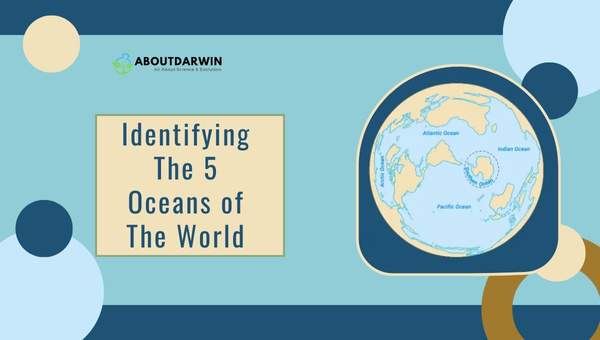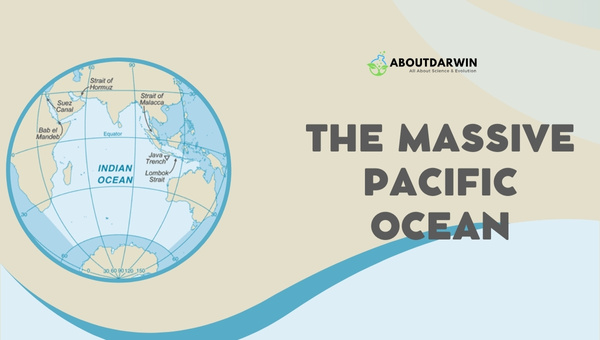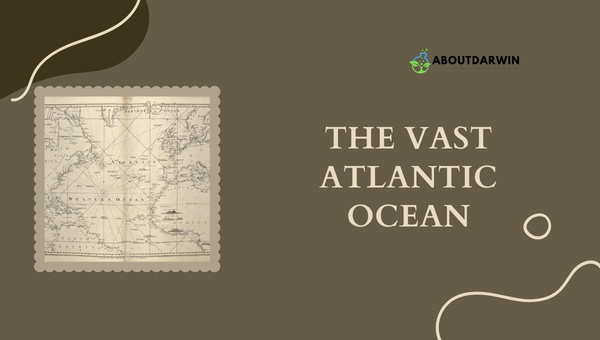Physical Address
304 North Cardinal St.
Dorchester Center, MA 02124
The Earth is covered by vast bodies of water, and among them, the five oceans of the world play a crucial role in shaping our climate, ecosystems, and human history.
Spanning over 71% of the planet’s surface, these oceans—Pacific, Atlantic, Indian, Southern, and Arctic—are not just geographical features; they are dynamic environments teeming with life and mystery.
Each ocean has its unique characteristics and significance, inviting exploration and study. What secrets lie beneath their waves? Let’s dive into the fascinating world of the oceans!
Contents
When it comes to examining the world’s massive bodies of water, it’s important to recognize the 5 main oceans that cover our planet.

While they’re interconnected and work together as one global ocean system, each retains its own unique characteristics.
Here’s a closer look at these oceans:
The geographies, sizes, and distinctive features of these 5 oceans allows us to appreciate their impact on Earth’s ecosystem, climate, and biodiversity. By distinguishing each of them, we’ll be better equipped to address the challenges that face our world and its oceans today.
Also Read: Sea Level Rise: Factors, Consequences & Mitigation
When thinking about the oceans that cover our planet, one can’t help but be awestruck by the sheer size and depth of the Pacific Ocean.

It’s the largest and deepest ocean on Earth, covering more than 60 million square miles and containing over half of the Earth’s open water surface. To give you some perspective, the Pacific Ocean is larger than all of Earth’s landmass combined!
Some astounding facts about the Pacific Ocean include:
The Pacific Ocean is divided into two parts based on its location:
The ocean’s vastness means that it has a significant impact on the Earth’s climate and weather patterns. For example, it plays a crucial role in the development and movement of El Niño and La Niña climate patterns, which influence weather all around the globe.
An astonishing variety of marine life thrives within the Pacific Ocean, including many endangered species such as the Hawaiian monk seal, blue whale, and leatherback sea turtle. The ocean’s biodiversity is truly remarkable, spanning from the tiniest plankton to the largest whales in existence.
| Species | Status |
|---|---|
| Hawaiian Monk Seal | Endangered |
| Blue Whale | Endangered |
| Leatherback Turtle | Vulnerable |
The immense volume of water in the Pacific Ocean also acts as a carbon sink, absorbing and storing large amounts of carbon dioxide (CO2) from the atmosphere, helping mitigate climate change’s effects.
However, increased absorption of CO2 has led to an alarming rise in the ocean’s acidity levels, posing a significant threat to marine life and ecosystems. The Massive Pacific Ocean is a wonder to behold, dominating our planet’s watery surface and harboring fascinating secrets beneath its waves.
With its vital role in climate, weather, and the well-being of countless species, it’s our responsibility to protect and preserve this incredible global resource.
Spanning a vast area, the Atlantic Ocean is one of the world’s 5 major oceans. It extends to about 41 million square miles, making it the second-largest ocean on Earth. Here, I’ll take a closer look at some of the features that define this remarkable body of water.

Its boundaries include the Americas to the west, Europe and Africa to the east, the Arctic Ocean to the north, and the Southern Ocean to the south. The Atlantic is also home to various seas and straits, such as the North, Mediterranean, and Strait of Gibraltar.
Its size and diverse environments create a range of climatic conditions, hosting a multitude of marine life.
Ocean depth and volume of the Atlantic displays an impressive range:
| Depth (ft) | Volume (cubic miles) |
|---|---|
| 27,480 | 74,471,500 |
The Atlantic Ocean’s floor is characterized by the Mid-Atlantic Ridge, a massive underwater mountain range formed by plate tectonics. Additionally, the ocean provides vital connections for international trade, as well as valuable resources such as oil and natural gas.
Interestingly, the Atlantic Ocean is expanding in size continually as the Earth’s tectonic plates shift. This constant motion affects not only the size but also the shape of the ocean floor.
Over the years, the Atlantic has emerged as a popular spot for exploration and scientific research, including the study of climate change due to its significant role in global weather patterns.
In addition to its abundant resources, the Atlantic is teeming with diverse marine life:
The Atlantic Ocean also holds great cultural significance, as it has served as a gateway for countless voyages, migrations, and trade exchanges throughout human history.
The Atlantic Ocean is an immense and extraordinary body of water with varying depths, volumes, and marine life. Its ongoing expansion, rich resources, and cultural significance make it one of our planet’s most fascinating and essential oceans.
Diving into the Arctic Ocean, I’m immediately struck by its icy and chilling nature. The smallest and shallowest of the world’s 5 oceans, it covers around 5.4 million square miles and boasts an average depth of about 3,953 feet.
Despite its smaller size, the Arctic Ocean plays a crucial role in regulating the planet’s climate and is home to an array of extraordinary marine life.
To give you an idea of the Arctic Ocean’s vastness, let’s break down its size and depth:
| Area (square miles) | Average Depth (feet) |
|---|---|
| 5,430,000 | 3,406 |
The Arctic Ocean is known for its distinctive ice cover, which varies throughout the year. During the winter months, the ice can extend southward towards the northern regions of Canada, Russia, and Scandinavia.
However, as the warmer weather arrives, the ice recedes, opening up passages for navigation and exploration. The dramatic shifts in ice cover contribute to the Arctic’s unique ecosystem and its matter of global concern – climate change.
Many marine species inhabit the Arctic Ocean, many of which are specifically adapted to thrive in this harsh environment. Some noteworthy creatures include:
Additionally, for those who appreciate natural beauty, the Arctic Ocean offers some of the most mesmerizing landscapes on Earth. From the swirling patterns of cracked ice to captivating underwater ice caves, the Arctic’s visually stunning features are awe-inspiring.
The Arctic Ocean is also of geopolitical significance, as there’s an ongoing race among countries for control over its natural resources. This ocean is believed to hold a large portion of the world’s undiscovered oil and natural gas reserves.
As polar ice melts due to climate change, the possibility of tapping these resources becomes more feasible, leading to concerns over environmental impact and political disputes.
While the Arctic Ocean may be the smallest of the 5 oceans, its importance cannot be underestimated. From its role in regulating the planet’s climate to its unique ecosystem and geopolitics, this icy ocean remains a fascination and concern for scientists and the global community.
Also Read: Understanding Eutrophication: Causes, Stages, Preventive Measure
The Indian Ocean is the third-largest body of water on our planet. Encompassing an astonishing 27.24 million square miles, it comes with numerous interesting features one might not be aware of. Let’s explore its warm waters and the remarkable attributes that come with it.
First off, it’s important to understand that the Indian Ocean is unique due to its warm water temperatures. Known as a tropical ocean, its temperature is consistently higher compared to the others. On average, the surface water temperature varies from 22°C to 28°C, making it the warmest of its kind.
These warmer waters play a crucial role in the lives of an abundant and diverse range of marine species. They provide ideal living conditions for the incredible underwater life that calls the Indian Ocean home. Some of these species include:
Moreover, the Indian Ocean Warm Pool (IOWP), an enormous region with temperature variations above 28°C, significantly affects the climate. With temperatures this high, it fosters the formation of intense monsoon systems in the area. As a result, countries surrounding the ocean, such as India, rely heavily on these annual monsoon rains for their essential water supply.
Another fascinating aspect is the Indian Ocean’s underwater topography. The vast ocean floor houses a multitude of unseen ridges, trenches, and basins. The most notable one is the Ninety East Ridge, which is a massive underwater mountain range stretching around 3,100 miles along the ocean floor.
Lastly, a vital aspect of the Indian Ocean is its significance in global trade. Due to its strategic location between Africa, the Middle East, and Asia, it acts as a critical link between the Eastern and Western worlds. Major shipping routes traverse its waters, with around 80% of the world’s oil exports being shipped through this body of water.
The Indian Ocean is a hub of activity and intrigue, both above and below its warm surface. Its unparalleled underwater life, substantial climate influence, majestic ocean floor, and vital shipping routes make it an essential part of our world.
The Southern Ocean is also known as the Antarctic Ocean. It’s the world’s youngest and coldest ocean. This body of water circulates around the continent of Antarctica and is responsible for regulating the Earth’s climate.
Differentiating itself from the four other oceans – the Atlantic, Pacific, Indian, and Arctic Oceans – the Southern Ocean is marked by its frigid waters and dramatic climate. While the temperature of its waters can vary, it mostly ranges from about -2°C to 10°C. This cold environment is home to some fascinating and hardy wildlife.
The Antarctic Convergence primarily marks the boundary of this ocean. It’s a natural boundary where the warm subantarctic waters meet and mix with the cold Antarctic waters. Not only does the Convergence create a unique, thriving ecosystem, but it also marks a distinct change in water temperature, salinity, and nutrient levels.
Here is a table with some key information about the Southern Ocean:
| Feature | Information |
|---|---|
| Size | 7.8 million sq miles (20.33 million sq km) |
| Average depth | 13,100 feet (4,000 meters) |
| Deepest point | South Sandwich Trench (23,740 feet/7,236 meters deep) |
While the Southern Ocean may be the smallest and youngest among the Earth’s oceans, it still holds some secrets of its own:
Given its unique characteristics and vital role in our planet’s well-being, the Southern Ocean holds a special place in the world’s geography. The ecological and geological wonders found in its icy depths make it an important area for scientific research and environmental conservation efforts.
The exploration of the 5 oceans of the world reveals their distinct characteristics and vital roles in Earth’s ecosystem. The Pacific Ocean, the largest and deepest, significantly influences global weather patterns, while the Atlantic Ocean serves as a crucial trade route and habitat for diverse marine life.
The Indian Ocean, known for its warm waters, supports unique biodiversity and impacts regional climates. The Arctic Ocean, despite being the smallest, plays a critical role in climate regulation.
Finally, the Southern Ocean surrounds Antarctica and is essential for scientific research and conservation efforts. Protecting these oceans is imperative for sustaining our planet’s health.